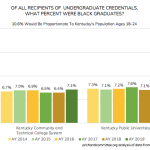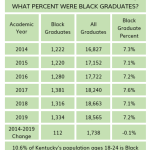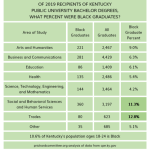Those three numbers are enough to tell us we don’t yet have the public education system we must build. This post will expand this main point by looking at trends over time and at variations by areas of study, but the main point should be clear already: our commonwealth has work to do.
TRENDS
Since 2014, Black students’ share of those credentials has risen slightly at KCTCS and declined very slightly at the universities.

Those nearly steady percentages have come while more people earned credentials overall. That is, since 2014, the institutions have increased their graduation numbers both for Black students and for all students. Here are tables making it easier to see both the growth in Black graduates and the lesser growth in Black percent of graduates.


AREAS OF STUDY
Zooming in on the fields in which students earned those degrees, there is important further variation.
In bachelor degrees, Black graduates received bachelor degrees at a rate a bit above their share of the state population in two fields: In trades and in social and behavioral sciences and human services. In other areas, results for those graduates were further from equity.

In the table above, let’s flag three areas of special concern:
- Kentucky expects science, technology, engineering and mathematics graduates to play important roles in innovation and economic development, yet that area is where Black graduates were the smallest proportion of graduates. From 2014 to 2019, Black STEM degree recipients rose more rapidly than total recipients, so we may be on the right path –and yet we clearly have very far to go.
- Health is another economic growth zone, but shows the third smallest level of Black graduates. Health also saw growth in Black graduates, but the pace there also left huge room for movement toward greater equity.
- Education majors teach our next generation, but our teaching force does not come close to resembling our public school enrollment. In 2019, Kentucky needed 3,023 more Black teachers to get to proportionality, and adding 86 Black education graduates cannot begin to move us to that needed level. Education saw growth in Black graduates while overall education degree recipients declined, but Kentucky needs greater growth to build learning opportunities for our next generation.
At KCTCS, there were no fields that reached 10.6%. STEM was again the area where Black graduates were least represented, though Health did better. In education, there were too few Black graduates for public reporting.

THE MAIN POINT
Kentucky’s public institutions of higher education are crucial to developing Kentucky talents fully, both to benefit individuals and to strengthen our economy and communities.
These numbers show an underdevelopment of Black talent that we must change. There are many things to say about how to do that, from raising Black high school graduations to reducing the costs of college attendance and on to building culturally responsive learning opportunities in every field. Every area where effort may be needed will require implementing strategies, investing resources, sustaining leadership, and building up community commitment.
But before we move to those issues, let’s say this first: Black minds matter, and the patterns shared here must change.


